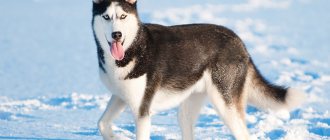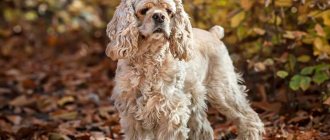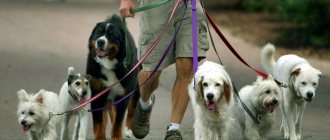- December 22, 2019
- Dogs and hunting with them
- Ekaterina Gordeeva
Once upon a time there was a man who dreamed of a dog with all his soul. Only this person was sincerely perplexed: what is the difference between dogs from elite nurseries and the most ordinary ones bought at the “bird” market or through an advertisement on the Internet? Why pay more for a puppy when you can get it cheaper?
And one day a man bought a dog from an advertisement. Together with the pet, the owner was given a small piece of paper with a seal, explaining that this was a real pedigree. But over time, it turned out that our hero was “cheated”, his dog was a cross between a “bulldog and a rhinoceros”, and his pedigree was “fake”.
Due to the fact that such situations occur quite often in everyday life, the question arises: how to check the pedigree of a dog? This is what we will talk about.
Pedigree is...
When planning to get a puppy, it is worth studying not only the characteristics of the desired breed, but also the nurseries that sell its representatives. Why nurseries with their sky-high prices? Yes, because when buying a puppy there, the owner will receive a real pedigree and will not find himself in the situation described above. It is unlikely that such an owner will have to think about how to check the dog’s pedigree in the future.
Let's start with the very concept of "pedigree". This is a document confirming the purebred of the animal. There are several types of pedigrees.
Zero or registered pedigree - what is it?
Such a pedigree does not fully convey information about the origin of the dog, as is necessary. Thus, the ancestors of this individual are either unknown or not recognized for some reason by the RKF and FCI. RKF does not recognize the pedigrees of SKOR, “Kind World”, etc. Important! Unrecognized pedigrees can be entered into the All-Russian Unified Pedigree Book (VERK), but with special marks and after a decision of authorized persons. The question arises: how to read the pedigree of a dog of this type? The whole problem is that it is not possible to read it, there is no data! For the same reason, she does not admit it. But if a descendant puppy has 3 officially registered generations (a full tree from animals with documents) from ancestors with “null”, then such a pedigree has the right to life and will receive recognition. Important! If the registered pedigree is stamped “Not subject to breeding,” then it will be impossible to register such a litter! But remember: this is a very troublesome and expensive matter, and it is not always possible to achieve a certain result, since the selection is very strict.
Types of pedigrees
We'll talk about how to check a dog's pedigree a little later. Now it’s worth considering the types of this document:
- An international pedigree is required to take a dog abroad. As a rule, such a document is needed for foreign exhibitions, matings and traveling with your pet.
- RKF pedigree is the most common option. RKF is the Russian Cynological Federation, in which nurseries engaged in breeding one or another breed are registered. The presence of the RKF pedigree confirms the purebred of the pet.
- Pedigree SKOR (Union of Cynological Organizations of Russia). Often, newbie dog lovers have a question: why are SKOR dogs worse than RKF dogs? The fact is that the RKF does not recognize pedigrees obtained from SKOR, therefore dogs from there are prohibited from taking part in exhibitions held under the auspices of the RKF. And SKOR dogs are much simpler in appearance than RKF dogs. To get a SCOR pedigree, it is enough to take the animal to a couple of exhibitions and get positive marks.
What is a puppy card and how is it different from a pedigree?
Before the puppies are 2 weeks old, the breeder notifies the Belarusian Cynological Association (member of the FCI - International Cynological Federation) about their birth. At the age of 30 - 60 days, puppies are examined by experts or the head of the club (if the club does not have BKO experts). Before sale, puppies are branded or microchipped. If the puppy was sold before being examined by an expert, a pedigree will not be issued for it.
Each puppy is given a puppy card. This is not a pedigree. In Western Europe, a puppy card contains information about 3 generations of ancestors. The puppy cards issued by BKO indicate the name of the puppy itself and the names of the parents, without mentioning more distant ancestors.
The breeder gives the puppy a nickname before examination by an expert. In one litter, all nicknames begin with the same letter and should not be longer than two words. All puppies in the litter must have different names.
The breeder may provide a puppy card or pedigree with the puppy. If you are issued a puppy card, it will be exchanged for a pedigree before the dog is 12 months old. The pedigree is drawn up by the BKO (at the request of the club in which the breeder is a member) and issued by the breeder. Often information about pedigrees is presented on nursery websites.
The breeder enters the surname and initials of the new owner and his address into the pedigree.
Obtaining a pedigree
Before you think about how to check a dog's pedigree, you need to understand how to get it.
The pedigree is obtained through the breeder after the dog reaches 15 months of age. Before this, the main document is the “puppy card” - a kind of pet birth certificate. Once the animal reaches the stated age, the “puppy” changes to pedigree.
By appearance
How to check the authenticity of a dog's pedigree? If the owner holds a document of a certain type in his hands, then he can be sure that the pedigree is real. It's all about the hologram and watermarks, which are noticeable upon closer inspection of the pedigree, as well as in the profile image of the greyhound.
Let's talk a little about deciphering the RKF pedigree. In the center are the dog's details: name, breed, date of birth, brand, color, breeder and owner. The document must contain information about the pedigree and its serial number in the RKF.
Under the numbers “1” and “2” are the dog’s father and mother, followed by grandparents, great-grandparents.
According to the application to the RKF
Is it possible to check the pedigree of a dog (RKF) using the brand number? We will talk about this below. Now let’s talk about such a moment as an application to the specified organization.
Attention! An application can be written only if the pet has the RKF mark, otherwise the owner will be denied consideration of his application.
The application can be submitted electronically on the official website of the RKF, but it is better to go to the organization and write it in person. Of course, this option is only suitable for residents of Moscow and the surrounding Moscow region. RKF is located at:
Moscow, st. Gostinichnaya, 9.
By brand
How to check a dog's pedigree by brand? It's not that easy, but it's quite possible. There are two ways:
- Directly in the RKF itself.
- Via the Internet on special sites dedicated to certain breeds.
If you need to check the pedigree of a dog using the brand number through the RKF, you can call this organization, provide the brand and ask for the pedigree number. This method exists, but rarely leads to positive results.
It is much easier and more effective to check the pedigree of a pet using the brand via the Internet. There are a great many websites - databases that contain information about representatives of a particular breed, and indicate nurseries in whose stud books these animals are registered.
The pedigree of the Russian Canine Federation (RKF) is a document confirming that your dog is purebred and that it is registered in the All-Russian Unified Pedigree Book (VERK), that is, it is an extract from the VERK RKF. This document also states that you are the owner of this dog.The Russian Canine Federation has decided to issue new breeding documents (Pedigrees) for dogs born on June 1, 2019, starting December 1, 2021. All old-style Pedigrees are valid indefinitely.
The new Pedigree form (extracts from the Verkhovna Rada of the Russian Federation) is issued in two versions.
First option.
CERTIFICATE OF DOG REGISTRATION IN VERK RKF.
It is issued in two languages (Russian and English) and contains the following information: registration number, dog breed, dog name, date of birth, gender, letter code and brand number, microchip number, color, surname, name and registration address of the breeder, surname, first name and the registration address of the dog's owner and about one generation of its ancestors (with pedigree numbers, full names, titles, working tests, health test results).
This version of the pedigree gives the right to participate in zootechnical events (exhibitions, competitions, etc.) at the national level and to obtain national titles. Does not give the right to participate in breeding. It is not a basis for registering a dog in the stud book of another country (in the event of the owner leaving for permanent residence abroad or transferring the dog into the possession of a foreign citizen).
In the upper right corner of the document there is a QR code, which makes it possible to view an electronic copy of the document in the Verk RKF database. ( QR Code Explanations for Pedigrees).
Sample Certificate of registration of a dog in the Verkhovna Rada of the Russian Federation
Second option
CERTIFICATE OF ORIGIN OF A SINGLE SAMPLE - extract from the Verkhovna Rada of Verkhovna RKF.
It is issued in two languages (Russian and English) and contains the following information: registration number, dog breed, dog name, date of birth, gender, letter code and brand number, microchip number, color, surname, name and registration address of the breeder, surname, first name and the registration address of the dog's owner, basic information about three generations of the dog's ancestors (pedigree numbers, full names, titles, working tests, health test results).
Such a pedigree gives the right to participate in any zootechnical events (exhibitions, competitions, etc.) in Russia and abroad, to obtain any national and international titles. If the necessary admission conditions are met, a dog with such a pedigree can be used in breeding.
In case of transfer of a dog into the possession of a foreign citizen, the mark “Export” is affixed to the Certificate of Origin of a single sample.
In the upper right corner of the document there is a QR code, which makes it possible to view an electronic copy of the document in the Verk RKF database. ( QR Code Explanations for Pedigrees).
Sample Certificate of Origin of a single sample
In accordance with the requirements of the RKF, a puppy card issued by a kennel is exchanged for a pedigree only by representatives of clubs or kennels.
The price of a puppy from our kennel includes the service of registration of the first version of the pedigree - a CERTIFICATE OF REGISTRATION OF THE DOG IN THE RKF Verktser.
This procedure usually takes about a month from the moment the litter is registered with the RKF.
At the owner’s request, we can issue a second version of the pedigree for an additional fee of 2,500 rubles (in accordance with the prices for RKF services).
If you find a dog on the street
So we found out how to check the pedigree of a dog by the number (RKF) of the mark. One of the easiest ways is a database provided on the Internet. Therefore, if you find a purebred (at first glance) dog on the street, first of all you need to examine it for the presence of a brand. For large dogs, it is usually placed in the ear or on the stomach. For small breeds - only on the stomach.
What is a brand?
Usually the brand is the first three letters of the name of the kennel, followed by the serial number of the dog. This serial number is entered into the pedigree, and the pet receives it at birth from the breeder. The breeder registers the newborn puppy in the nursery's stud book, recording its serial number. For example, if the puppy is the 200th born in this kennel, then its number will be “200”.
An example of a nursery brand: LIN 123. We have found out what the numbers and letters mean.
We are looking for owners
You are lucky, the dog has a mark, and we managed to find out which kennel your find came from. The next step is simpler: we find the website of this nursery and the phone number of the breeder, call him and find out who the owners of the animal are.
If you advertise online that you have found a dog, be careful. “Owners” will come running for free, many want to take a purebred pet “for free,” but you are not a mistake either. Ask potential owners to check the dog's name and brand number.
How to make a zero pedigree for a dog
The sequence of actions may seem simple, but in reality, registering a pedigree requires time and money. So, the conditions for issuing a zero pedigree dog are described below.
The dog must have a clearly legible mark. If you don’t have a brand, you need to contact the club (in the RKF system), where the animal will be registered and given a brand number. If you already have a stamp, but the code was issued by another organization that does not work in the RKF system, you will still have to make another stamp. You can make a brand at a veterinary clinic or any other establishment that provides branding services, the main thing is that the number is already known. In the future, the brand will be indicated in breed description forms.
At the next stage of registration of a zero pedigree, you need to sign up for exhibitions to receive expert assessments. It should be taken into account that if a Certificate of Origin is available, but it is not recognized by the RKF , then a registered Certificate of Origin is issued to dogs provided that:
- establishing their compliance with the standard (where the breed, origin and affiliation of the animal to the owner, brand or chip are indicated);
- receiving in a separate ring at exhibitions of the rank of CHK, PC, CCC;
- exterior grades not lower than “very good” and included in the exhibition catalogue.
In this case, a registered Certificate of Origin will be issued without information about parents and ancestors, with the right to breed.
If there is no pedigree , then provided:
- establishing the dog's compliance with the breed standard;
- receiving in a separate ring at exhibitions of the rank CAC, CHK, PC, CCC;
- grades for the exterior are not lower than “satisfactory” and are included in the exhibition catalogue.
Then they will issue a primary register Certificate of Origin without information about parents and ancestors, with the information entered into the VERK and with a note on the Certificate - “Not subject to breeding.”
It is better to choose exhibitions that take place simultaneously on the same day, which will allow several experts to attend on the same day. Registration for exhibitions is normal, but the organizers must be warned in advance that the dog is being registered for the purpose of obtaining a registered pedigree. The organizers must include the dog in the exhibition catalogue.
It is necessary to prepare a set of documents. Experts will enter the description of the dog into a Special Dog Description Form to confirm compliance with the breed, which can be downloaded and printed (at least 2 copies) from the RKF website, in the application section.
Next, you need to take 2 color photographs of the animal in a stand - in profile and full face, as well as the brands (the place where it is located). The dog in the photograph must be completely visible, i.e. it is unacceptable for the tail or ears to be cut off. Photographs are taken in duplicate, usually on A4 sheets.
When taking part in several exhibitions taking place on the same day, you need to have a set of documents with you, consisting of forms (in two copies) and photographs (in two copies), which is needed for each judge. In addition, you need a veterinary passport, filled out (indicating the name, breed) and with notes on rabies vaccinations.
An expert certified for this particular breed gives a description of the dog after assessing its stance, movements, and compliance with breed characteristics. Then the expert must sign on each form and on the back of each photograph, indicating the date, brand, his full name, and the number of the judge's sheet.
One set of documents remains with the organizers, who send them to the RKF within a month, and the dog owner independently provides the second set to the RKF. You don’t have to wait for the organizers to send the documents to the RKF, but put their stamp on the documents - letterhead, photographs, in the catalog on the page where the dog is listed, and take these documents to the RKF yourself.
To obtain a zero pedigree, being the owner of a dog, you must submit to any RKF Federation three completed Special Forms describing the dog and 2 photographs with the signatures of the judges, indicating the numbers of the judges' sheets and telephone numbers and the original of the unrecognized RKF or FCI pedigree (if available).
A little about SKOR pets
Do you need to check the pedigree of a dog registered with SKOR? In fact, there are much more problems with such animals than with those registered in the RKF. Why? Yes, because SKOR has simplified requirements for obtaining pedigrees for its dogs, unlike the Russian Cynological Federation.
But this is a small digression. In order to check information about the dog's pedigree number in SCOR, you must follow the verification algorithm in RKF. The ideal option would be to search for the mark in the appropriate database, contact the breeder and subsequently the owner of the animal. But this is the case when we are talking about a found dog.
Where and how to look for a dog?
In principle, there’s no point in making any guesses here: you need to search for the dog exactly in the place where it got lost, and it also wouldn’t hurt to look into the places where it often walked with its owner. Keep in mind that the pet's sense of smell helps him navigate , therefore, if you place personal belongings near the walking area, the dog will know about it and will come to wait for the owner.
Posting advertisements can also be of great help in finding a lost dog. When compiling them, you need to describe the appearance of your pet in all details, add a photo, and additionally indicate the reward . When writing an ad, it is recommended to omit the information that you have a rare breed dog. It is unknown who will contact you, because if they are scammers, then they can take advantage of the opportunity to profit from your grief.
Make sure that the tear-off strips on which you need to briefly write text with the dog’s characteristics are large.
After all , not everyone can remember this information after reading it .
It is recommended to post advertisements at the nearest veterinary hospital, pharmacies and pet stores. You should look in places where a lot of people gather, as well as near garbage containers and where other owners walk their pets. If your dog is missing at your dacha , then you should look in nearby villages. You might even want to reach out to schools and playgrounds asking the children to help. After all, they definitely won’t refuse the opportunity to earn money and participate in such an exciting business.
I would like to give one more valuable recommendation regarding the search for a lost dog. You should definitely visit all dog foster care centers, veterinary septic tanks and shelters . And during each visit, be sure to give employees a notice. Be sure to inform club representatives, breeders and kennels about the presence of a brand on your dog.
How to find a lost dog: chip
If you want to avoid losing your pet, you should use technical, psychological and training techniques.
The chip is a device no larger than a grain of rice that is inserted subcutaneously into the dog's withers. This complex technical device records biometric data about the animal and its affiliation. Using a chip, you can easily determine the location of a dog , for example, when it crosses a border. In accordance with current rules, animals can be transported abroad only with electronic identification. Therefore, if you have an electronic passport, then you can be calm about your pet.
Although some organizations are extremely critical of such measures, RFID chips have been increasingly used by many owners in recent years.
In modern conditions, microchipping of animals has become a mandatory procedure that not only employees of canine organizations must undergo. Let's say, if you wanted to go to Japan, then your dog must be microchipped. If the animal has a chip that differs from the ISO standard adopted in Japan, then you will have to take the appropriate scanner with you.
- A microchip is a very reliable device that will help you locate your dog throughout his life. After completing the chipping procedure, its owner will be issued a registration certificate in the form of a secure plastic card. This document will contain all the information about both the pet and the owner, the place and date of issue of this chip.
- Such a certificate is officially recognized as a document that gives the right to own an animal. Sometimes, when controversial situations arise about the ownership of a found animal, such a certificate can be considered as a legal document.
- After installing an individual chip, the animal enters a single electronic database. Therefore, if you need to get more detailed information about the chip, you can refer to it. The national electronic identification database Russiapet.net is a large-scale repository of data on Russian animals that have a microchip or special tattoos as means of identification.
- Chips for dogs are quite affordable and cost approximately 400–500 rubles. Therefore, if you want to protect yourself from losing your pet, then do not deny yourself the opportunity to have your dog microchipped.
Problems when checking pedigree
Alas, representatives of the RKF and other cynological organizations often refuse to provide information about the dog’s pedigree. This is not surprising, since the pedigree is the main document, which, if translated into human language, is the animal’s passport. Who will provide passport data to a stranger? The same is true with the pedigree; it is easier to check the data on an animal by brand than to check the dog’s pedigree using the RKF number. After all, each such document has a specific number assigned to the animal in a given organization. If, of course, the nursery where the dog was born is registered with the RKF.
If there's nothing
What to do when you find a dog on the street, but there is no mark or chip? Moreover, it is clear that the animal is purebred, as evidenced by its exterior, but it is impossible to check the presence of a pedigree and find out which kennel the dog is from. In this case, it will not be possible to check the pedigree; you will have to look for the owners in other ways.
One option is to post about the found dog on social networks, taking several photos of the animal. It is advisable to post this post in local city public pages (groups), as well as on free city bulletin boards. You just have to be vigilant, because you never know who will want to introduce themselves as the owner.
In correspondence or telephone conversation with the owner, be sure to ask for the animal’s name, age, and special features. The owner wants to come pick up the dog? Very cool, just let him take his passports with him, both his own and the veterinarian’s. Isn't there any of this? To no, as they say, there is no trial.
What if the owner threatens to write a statement to the police, considering the person who found the dog guilty of stealing it? If there are no documents confirming that the animal is the property of this person, the latter will not be able to do anything. Be that as it may, a dog is property, and property requires certain documents. In our case, a pedigree indicating the initials of the owner.
How to find a dog's owner by brand if there is no data on the Internet
The main thing you should never forget: if a dog has a mark, it is unlikely that it was simply abandoned to the mercy of fate; there will definitely be those who are familiar with the dog or its owners.
First of all, you need to independently post information about the animal in special groups on social networks that specialize in searching for missing animals in various cities of Russia. Breed forums will also come to the rescue, “breeders” often unite in clubs, surely someone will recognize the dog, there will be “littermates” (brothers and sisters of the foundling), and the fate of the dog will no longer be so vague.
Now, the dog’s brand number cannot be published in full; it must be provided by the owners themselves. It is enough to indicate only the first letters, allowing you to understand in which nursery the animal was born. Otherwise, simple swindlers who want to appropriate someone else's property may call. By the way, it is also better not to leave your address or phone number in the public domain; it is better to limit yourself to an email address.
If your dog is missing
Be prepared for the fact that those who find them will ask for a certain reward for the capture and maintenance of the animal. Of course, you can be indignant, and even contact the police, but anything can happen in life, and there are no guarantees that the dog will not disappear again. And then, if the animal is found by the same people, everything can turn out very badly.
So prepare a reward, the animal’s pedigree, your passport and name the distinctive features of the dog, its name and age.
What dogs are branded?
Each club or kennel is obliged to assign a brand to each puppy born within its walls, regardless of the class assigned to it. If the club sold a puppy without a brand, it violated the breeding regulations. In this case, the buyer has no guarantee that the puppy was purchased exactly as indicated in the documents.
However, if you have the appropriate documents, you can brand an adult dog, although you may be advised to have your pet microchipped.
Important! If you decide to brand an adult dog, make sure that the dog can withstand the branding procedure and not cause damage to the master.
The mark, which is included in the RKF database, is applied only to pure breed puppies with the necessary documents. In the absence of documents, it is possible to apply a stamp only in the form of the owner’s telephone number.
If the mark has become blurry with age, it can be updated. But for this, again, it is important to provide supporting documents.
Why do you need a pedigree at all?
First of all, in order to have proof of the purebred dog and its belonging to a certain breed. Pedigree is not a panacea for all ills; there are dogs from good kennels with an excellent pedigree, but a problematic psyche. However, this document gives at least some kind of guarantee to the owner.
The second point is what is described above. Pedigree is the main canine document. If an animal is lost or stolen, it will be much easier to return the pet. Dogs registered with the RKF must have a mark, which can be used to identify the nursery where the animal was taken from, contact the owner and return the pet to him.











